Abstract
A total of 3,446 publications regarding sciatic nerve injury repair and protection indexed by Web of Science during 2000–2004 were used for a detailed analysis of temporal-spatial distribution characteristics. Reference co-citation networks of the 100 top-cited publications as per the number of total citations were created using the Web of Science database and the information visualization tool, CiteSpaceIII. The key words that showed high frequency in these publications were included for analyzing the research fronts and development trends for sciatic nerve injury repair and protection. Through word frequency trend analysis, studies on bone marrow mesenchymal stem cells, adipose-derived stem cells, and skeletal muscle-derived multipotent stem cells combined with tissue-engineered scaffold material will become the forefronts in the field of sciatic nerve injury repair and protection in the near future.
Keywords: nerve regeneration, sciatic nerve injury, nerve repair, neuroprotection, reference co-citation networks, Web of Science, CiteSpace, neural regeneration
Introduction
The sciatic nerve is the longest and widest nerve in the body and composed of the spinal nerves between lumbar segments 4 and 5 and between sacral segments 1 and 3. An injury to any segment of the sciatic nerve is closely related to local anatomy, and sciatic nerve injury at the buttocks is one of the most intractable peripheral nerve injuries with the poorest therapeutic effects (Noorafshan et al., 2012). If appropriate treatment is not given after sciatic nerve injury, the recovery of the injured nerve can be inhibited by neuromas that often form during neurite regeneration, and the regeneration and function of injured nerves can be affected by the gaps produced by neurotmesis (Ahn et al., 2010; Keast et al., 2010; Shi et al., 2011). Although nerve autografts are currently the most effective method to repair injury, many problems are associated with it. These include a limited source from the donor, loss of function in donors and risk of secondary surgery (Schmidt and Leach, 2003; Chen et al., 2010; Eggers et al., 2010). With the rapid development of nerve tissue engineering in recent years, construction of nerve conduits has become a promising method for repair of nerve defects. Nerve conduit scaffolds made of collagen and chitosan exhibit good histocompatibility and are widely used in the field of biomedicine. Tissue-engineered nerve conduit scaffolds combined with neurotrophic factors can decrease the activity of acetylcholinesterase, promote neuronal differentiation, growth, and neurite formation, and provide nutrition to the peripheral nerve (Kokai et al., 2010; Kokai et al., 2011), thus contributing to peripheral nerve repair. Bioengineered nerve grafts loaded with an extracellular matrix and growth factors or cell transplantation for repair of peripheral nerve injury have also become a growing area of interest in the field of peripheral nerve injury. Despite this, peripheral nerve injury is very common and treatments are still not fully successful. Thus peripheral nerve injury repair and promoting the regeneration of injured peripheral nerves have become important issues in both basic research and clinical studies.
CiteSpaceIII is an information visualization tool developed by Professor Chaomei Chen from Drexel University, Philadelphia, USA. It is the most characteristic and influential application software in the field of visualization analysis (Chen, 2006, 2009). It can visualize and analyze the trends and patterns in a field or domain within a designated period of time. CiteSpaceIII visualizes the knowledge domain as a time-variant duality between research fronts and knowledge bases to help investigate the dynamic mechanism underlying science development based on the time mapping from research fronts to knowledge base (Chen, 2006).
An increasing area of interest in the field of information science is to analyze the study dynamics and development trends in specialist research fields using knowledge mapping (Chen, 2006, 2009). CiteSpace has used published literature to analyze the knowledge structure, intellectual turning points and pivotal points in the research fields of regenerative medicine, cloud computing, nervous system science, higher education, nanometer biomedicine, knowledge management, society network, information resource management, and artificial intelligence. However, literature presenting a knowledge-mapping analysis on research trends and fronts in the repair and protection of sciatic nerve injury using such a visualization tool is scarce.
Data and Methods
Data sources and methodology
A Web of Science-based online retrieval (http://apps.webofknowledge.com) was performed by the first author using the key words “sciatic nerve” OR “sciatic-nerve” and “repair” OR “regeneration” OR “protect” to find research articles or reviews on sciatic nerve injury repair and protection published in English during 2000–2014. The search was carried out on 15th August 2014 and 3,446 publications were included in the final analysis.
Inclusion criteria
We included peer-reviewed articles, including original studies, basic research and reviews published in English and indexed in Web of Science during 2000–2014.
Exclusion criteria
We excluded publications that required manual searching or telephone access, documents that were not published in the public domain, meeting abstracts, proceedings, corrected articles, and repeated articles.
The 100 top-cited publications were downloaded with information including authors, title, abstract, and descriptors and identifiers, and their 2,347 citations. The downloaded data were analyzed by the CiteSpaceIII visualization tool.
Results
Analysis of publications on sciatic nerve injury repair and protection published in Web of Science during 2000–2014
The number of publications regarding sciatic nerve injury repair and protection in Web of Science during 2000–2014 is shown in Figure 1.
Figure 1.
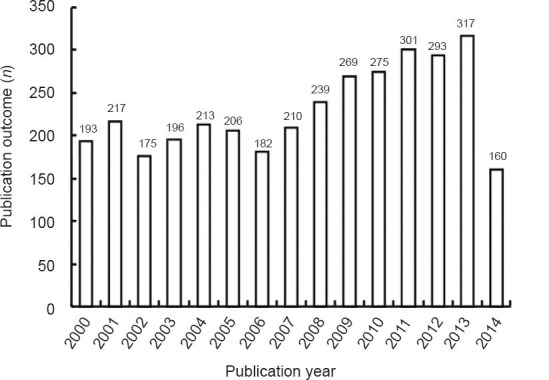
Annual publication output regarding sciatic nerve injury repair and protection in Web of Science during 2000–2014.
A total of 3,556 publications on sciatic nerve injury repair and protection were published during 2000–2014 and retrieved from Web of Science. Among them, 3,446 publications were either original articles or review articles. The number of relevant publications gradually increased over the 10-year study period. In the included years, the number of Web of Science publications increased very slowly until 2007, and then significantly increased after 2010. The number of Web of Science publications in 2013 (n = 317) was nearly twice that in 2000 (n = 193).
A distribution of countries publishing papers on sciatic nerve injury repair and protection indexed in Web of Science during 2000–2014 is shown in Figure 2.
Figure 2.
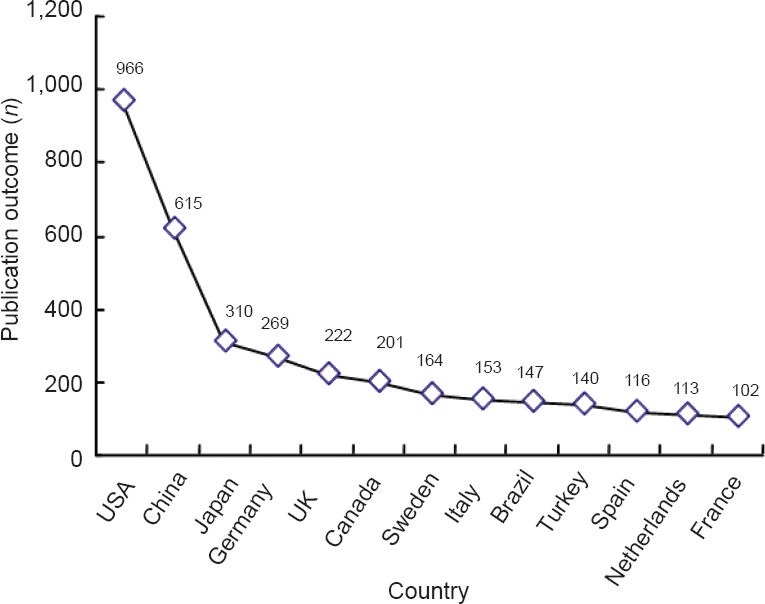
Distribution of countries publishing more than 100 papers on sciatic nerve injury repair and protection, indexed in Web of Science during 2000–2014.
The USA (n = 966) published the highest number of papers on sciatic nerve injury repair and protection, followed by China (including Taiwan, n = 966), Japan (n = 310), Germany (n = 269), the UK (n = 222) and Canada (n = 201). The total number of publications from the USA and China account for nearly half of all studies in all countries. The majority of countries producing over 100 publications were developed countries.
The institutes that produced these publications are shown in Table 1.
Table 1.
Distribution of institutes publishing more than 50 publications on sciatic nerve injury repair and protection indexed in Web of Science during 2000–2014
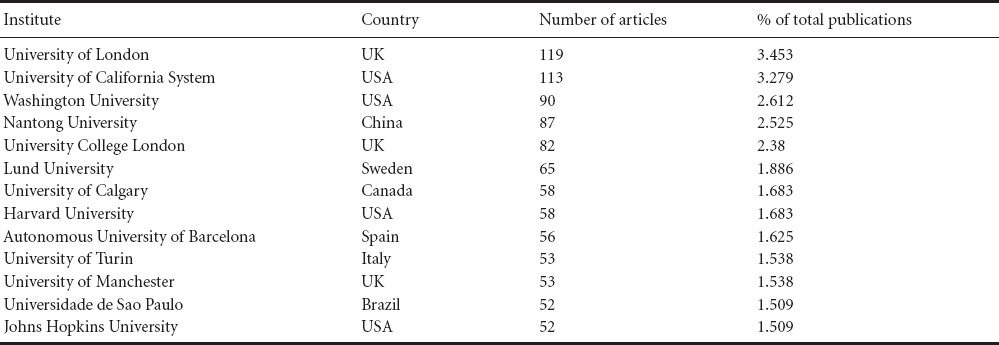
The University of London (UK) produced the highest number of publications (n = 119), followed by University of California System (USA; n = 113). Washington University (USA; n = 90), University College London (UK; n = 82), and Lund University (Sweden; n = 65). Among the institutes that had more than 50 articles, Nantong University in China ranked fourth.
Temporal-spatial distribution characteristics of the 100 top-cited publications on sciatic nerve injury repair and protection indexed in Web of Science during 2000–2014
Over the study period, the 100 top-cited publications on sciatic nerve injury repair and protection came from 14 countries. Among these countries, the USA produced the highest number of publications (n = 51, 51%), indicating that the USA takes a leading position in the study of sciatic nerve injury repair and protection; the UK and Canada ranked second, with 13 publications (13%) for each; Germany published eight publications (8%); and China and Japan each had six publications and ranked fourth.
The distribution of institutes with the 100 top-cited publications on sciatic nerve injury repair and protection indexed in Web of Science during 2000–2014 is shown in Table 2.
Table 2.
Institutes that had more than five top-cited publications on sciatic nerve injury repair and protection indexed in Web of Science during 2000–2014

The University of London published 12 papers on sciatic nerve injury repair and protection and ranked first, followed by Johns Hopkins University with nine publications, and the University of Alberta and University College London with eight publications each. No Chinese institute yielded publications on sciatic nerve injury repair and protection that were classed in the 100 top-cited publications indexed in Web of Science during 2000–2014.
The distribution of journals for the 100 top-cited publications on sciatic nerve injury repair and protection indexed in Web of Science during 2000–2014 is shown in Table 3.
Table 3.
Journals for the 100 top-cited publications on sciatic nerve injury repair and protection in Web of Science during 2000–2014
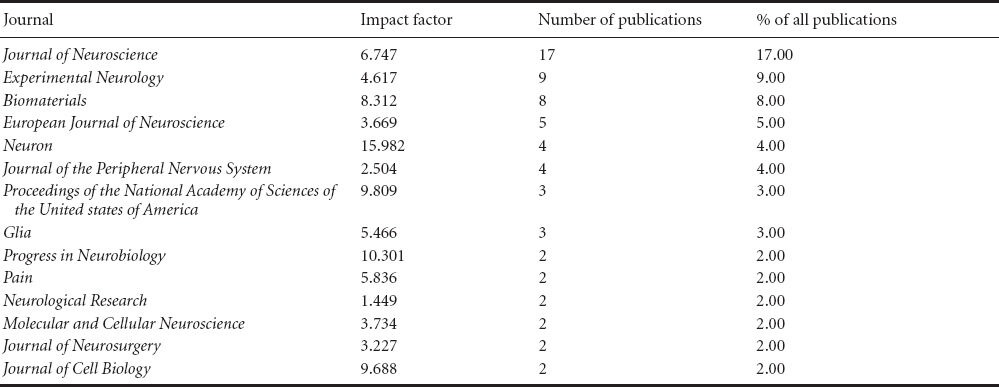
The five top-cited publications on sciatic nerve injury repair and protection indexed in Web of Science during 2000–2014 are shown in Table 4.
Table 4.
Five top-cited publications on sciatic nerve injury repair and protection indexed in Web of Science during 2000–2014

Tsujino et al. (2000) published an article in Molecular and Cellular Neuroscience and had the highest number of citations. This article primarily examined the expression and regulation of activating transcription factor 3 (ATF3) after axonal injury in neurons in the dorsal root ganglia and spinal cord. They concluded that ATF3 is specially induced in sensory and motoneurons in the spinal cord after nerve injury and is considered a distinct neuronal marker of nerve system.
Al-Majed et al. (2000) published an article in Journal of Neuroscience and ranked second in the number of total citations. They used a rat model of femoral nerve transaction to evaluate (1) the effect of nerve transaction on the speed of regeneration and the generation of motor-sensory specificity; (2) the efficacy of electrical stimulation in accelerating axonal regeneration and prompting the reinnervation of appropriate muscle pathways by femoral motor nerves; and (3) the mechanism of action of electrical stimulation. They used fluorogold and fluororuby to label the motoneurons that regenerate axons into muscle and cutaneous pathways and found that (1) 10-week axonal outgrowth greatly delays axonal regeneration (staggered regeneration), the process of which was associated with preferential motor reinnervation; (2) 1 hour to 2 weeks of 20 Hz continuous electrical stimulation of the parent axons near the repair site significantly reduced this period and accelerated preferential motor reinnervation; (3) the beneficial effect of short-term electrical stimulation was mediated by the cell body, involving an enhanced growth program. Based on the efficacy of this short-term low-frequency electrical stimulation, a novel therapeutic approach was proposed to accelerate nerve regeneration post-injury and thereby to improve functional recovery.
Quantitative studies on the 100 top-cited publications on sciatic nerve injury repair and protection indexed in Web of Science during 2000–2014
Academic publications are an important component in reflecting study outcomes. The number of citations is a method used to evaluate the influence of a scholar or publication in the corresponding field. The number of citations of an article is of great significance for authors, journals and publication institutes (Adam, 2002). A large number of citations mean that the author's research has been effectively propagated and widely accepted. Although the number of citations has obvious shortfalls in the evaluation of publication quality, it is still currently a widely accepted method of judging a journal or article (Nason et al., 2013). Recently, the number of citations has also been used as a standard for searching “classical literature” (Moed, 2009; Rosenberg et al., 2010).
Important studies on sciatic nerve injury repair and protection field
The 100 top-cited publications on sciatic nerve injury repair and protection indexed in Web of Science during 2000–2014 were analyzed using the CiteSpaceIII visualization tool, with a Time Slicing value of 1. The dataset selected during 2000–2014 was divided into 15 parts. The 50 top-cited publications in each part were selected, with thresholds of “(2,2,20), (4,3,20), (4,3,20)”, node type of “burst terms”, and pathfinder network scaling selection. Thus, visualized networks for co-cited burst terms were created.
The study fronts in a field or domain are reflected via the positive citations of publications and represent the thinking status of a research field. The publications most cited are located in the center and become the core achievement in this research field, but there is no direct causal relationship between the citation frequency and contribution of this publication in the study progression. The contribution of the publication in study progression is embodied by burst terms. New trends and bursts of scientific publications appear because of the following factors: (1) proposing a new finding or major scientific breakthrough in a publication; and (2) enlightening scientists to study issues from a new prospective (Chen, 2004). Based on co-citation networks, top-cited publications were further analyzed to investigate the study fronts on sciatic nerve injury repair and protection. Eight publications were included in the core publications of this cluster and were also the core publications of the whole co-citation networks. Of these eight publications, each had a new finding and induced a new trend of the study, guiding a new orientation (Table 5).
Table 5.
Eight classical publications retrieved by the CiteSpaceIII visualization tool

Co-citation cluster refers to a network formed by co-cited publications and is used to investigate study fronts. The co-citation cluster of publications on sciatic nerve injury repair and protection is a network map with an appearance similar to round. Each cluster in the periphery is relatively independent, and the cluster network taking the publication by Fu as the center is interlaced and closely linked together. The modularity Q was 0.8389 and the silhouette was 0.8308. These data suggest that co-cited publications form an obvious and relatively independent cluster network, and they also indicate that the label of each cluster is relatively accurate. This provides reliable evidence for data analysis.
Based on the included co-cited publications in this study, 22 co-citation clusters formed and were named according to the number of publications in each cluster. In this study, we analyzed the largest seven co-citation clusters (clusters 0–6; Table 6). According to the label used in the co-citation cluster, scholars have performed studies on sciatic nerve injury repair and protection from different perspectives. Through analysis of these top-cited publications, studies mainly focus on materials, especially tissue-engineered materials, which embody the study focus of sciatic nerve repair and protection.
Table 6.
The largest seven co-citation clusters of publications taking key words as the label
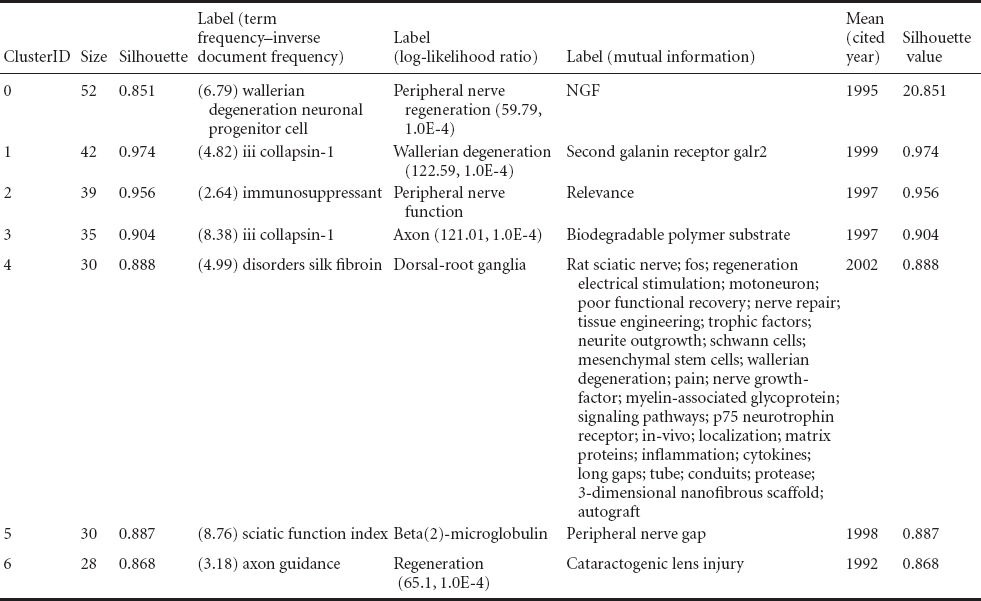
Visualized analysis on hotspots in the field of sciatic nerve injury repair and protection
Visualized networks for co-cited burst terms were created using the pathfinder method based on the following parameters: key word: node of network; node type: noun phrases; time zone: 1 year; and thresholds: (2,2,20), (3,3,20), (3, 3, 20). As shown in Figure 3, there were 247 nodes and 604 lines.
Figure 3.
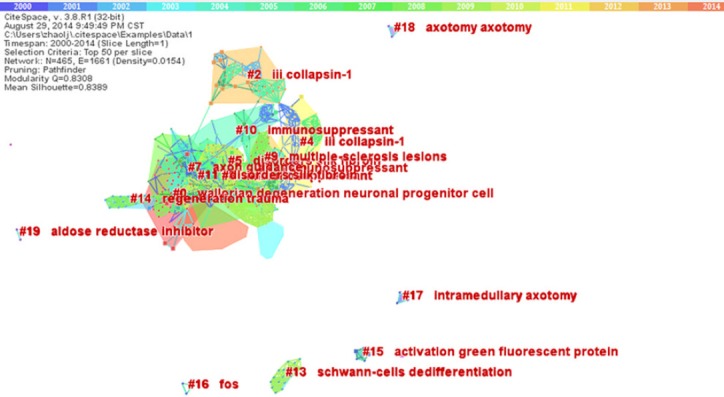
Trajectories of relevant research shown in a hybrid network of co-cited references and burst terms from titles and abstracts.
To further understand the hotspot in each period of time, a time zone view was used to analyze the hotspot and took key words as the label, which helped us to understand the development of a field or an issue. According to the citation frequency and centricity, a hotspot in each period of time was selected. Based on the citation frequency and centricity of a key word, repair by tissue engineering and inflammatory control are considered the areas of interest in the field of sciatic nerve injury repair and protection (Figure 4).
Figure 4.
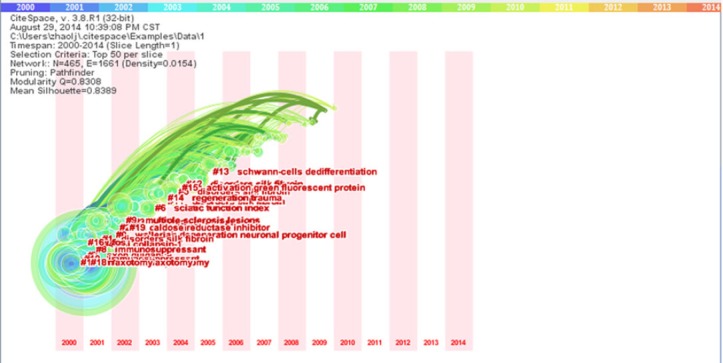
High-frequency key words used in publications on sciatic nerve injury repair and protection indexed in Web of Science during 2000–2014.
Conclusion
A total of 3,446 publications on sciatic nerve injury repair and protection were indexed in Web of Science during 2000–2014. Over the study period, the number of publications on sciatic nerve injury repair and protection gradually increased. The number of Web of Science publications in this field increased slowly in 2002, but the increase was sharp after 2010, and the number of Web of Science publications in 2013 (n = 317) was nearly twice that in 2000 (n = 193). These findings suggest that the field of sciatic nerve injury and protection was in a stage of development during 2000–2013. The USA and China rank at the top in the number of publications, and the total number of publications from these two countries accounts for nearly half of all the publications included. The scientific research in China is encouraging. However, among the 100 top-cited publications on sciatic nerve injury repair and protection, none come from a Chinese institute.
The publication with the highest number of citations was published in 2000 and was cited 321 times, a mean of 21.40 times per year. Since 2005, there were few highly cited publications, which may be due to the inherent bias of citation analysis (Gisvold, 1999). The total number of citations will increase with time; compared with newly published publications, the earlier the published publication, the more citations it will receive. Publications produced after 2005 have fewer opportunities to be cited, which may influence their overall number of citations.
The 100 top-cited publications on sciatic nerve injury repair and protection originate from 14 countries. The USA is ranked first, suggesting it takes a leading position in studying sciatic nerve injury repair and protection. The UK and Canada ranked second, with 13 publications in each country. Germany had eight publications (8%). China and Japan ranked fourth, with six publications each.
Among the included institutes, the University of London had 12 publications on sciatic nerve injury repair and protection and ranked first, and Johns Hopkins University had nine publications and ranked second. The University of Alberta and University College London each had eight publications. Among the 100 top-cited publications on sciatic nerve injury repair and protection indexed during 2000–2014, none came from a Chinese institute. Among the 100 top-cited publications on sciatic nerve injury repair and protection indexed in Web of Science during 2000–2014, Journal of Neuroscience had 17 publications and ranked first.
Through bibliometric analysis and visualization findings, publications (on sciatic nerve injury repair and protection) from American academic institutes of excellence, and those peer-reviewed and published in high-impact-factor journals, have a preference to be cited.
Visualized networks for co-cited burst terms in the field of sciatic nerve injury repair and protection were created using the information visualization tool CiteSpaceIII and six publications with significant influence were acquired. Through word frequency analysis, the areas of interest in the field of sciatic nerve injury repair and protection can be determined. These include: reparative factors (including neurotrophic factor, brain-derived neurotrophic factor, transforming growth factor, glial cell line-derived neurotrophic factor and extracellular matrix) and reparative materials (polyglycolic acid, polylactic acid, poly(lactic-co-glycolic acid), poly(lactic-co-glycolic acid), polycaprolactone, and collagen-chitosan scaffolds). Through word frequency trend analysis, studies on bone marrow mesenchymal stem cells, adipose-derived stem cells, and skeletal muscle-derived multipotent stem cells combined with tissue-engineered scaffold material will become the forefronts in the field of sciatic nerve injury repair and protection in the near future.
Footnotes
Copyedited by Paul P, Robert J, Zhao LJ, Li CH, Song LP, Zhao M
References
- 1.Adam D. The counting house. Nature. 2002;415:726–729. doi: 10.1038/415726a. [DOI] [PubMed] [Google Scholar]
- 2.Ahn M, Jin JK, Moon C, Matsumoto Y, Koh CS, Shin T. Glial cell line-derived neurotrophic factor is expressed by inflammatory cells in the sciatic nerves of Lewis rats with experimental autoimmune neuritis. J Peripher Nerv Syst. 2010;15:104–112. doi: 10.1111/j.1529-8027.2010.00258.x. [DOI] [PubMed] [Google Scholar]
- 3.Al-Majed AA, Neumann CM, Brushart TM, Gordon T. Brief electrical stimulation promotes the speed and accuracy of motor axonal regeneration. J Neurosci. 2000;20:2602–2608. doi: 10.1523/JNEUROSCI.20-07-02602.2000. [DOI] [PMC free article] [PubMed] [Google Scholar]
- 4.Chen C. Searching for intellectual turning points: progressive knowledge domain visualization. Proc Natl Acad Sci U S A 101 Suppl. 2004;1:5303–5310. doi: 10.1073/pnas.0307513100. [DOI] [PMC free article] [PubMed] [Google Scholar]
- 5.Chen C. CiteSpace II: detecting and visualizing emerging trends and transient patterns in scientific literature. J Am Soc Inf Sci Technol. 2006;57:19. [Google Scholar]
- 6.Chen C, Chen Y, Horowitz M, Hou H, Liu Z, Pellegrino D. Towards an explanatory and computational theory of scientific discovery. J Informetr. 2009;3:19. [Google Scholar]
- 7.Chen J, Chu YF, Chen JM, Li BC. Synergistic effects of NGF, CNTF and GDNF on functional recovery following sciatic nerve injury in rats. Adv Med Sci. 2010;55:32–42. doi: 10.2478/v10039-010-0020-9. [DOI] [PubMed] [Google Scholar]
- 8.Dimar JR, 2nd, Glassman SD, Raque GH, Zhang YP, Shields CB. The influence of spinal canal narrowing and timing of decompression on neurologic recovery after spinal cord contusion in a rat model. Spine (Phila Pa 1976) 1999;24:1623–1633. doi: 10.1097/00007632-199908150-00002. [DOI] [PubMed] [Google Scholar]
- 9.Eggers R, Tannemaat MR, Ehlert EM, Verhaagen J. A spatio-temporal analysis of motoneuron survival, axonal regeneration and neurotrophic factor expression after lumbar ventral root avulsion and implantation. Exp Neurol. 2010;223:207–220. doi: 10.1016/j.expneurol.2009.07.021. [DOI] [PubMed] [Google Scholar]
- 10.Gisvold SE. Citation analysis and journal impact factors--is the tail wagging the dog? Acta Anaesthesiol Scand. 1999;43:971–973. doi: 10.1034/j.1399-6576.1999.431001.x. [DOI] [PubMed] [Google Scholar]
- 11.Keast JR, Forrest SL, Osborne PB. Sciatic nerve injury in adult rats causes distinct changes in the central projections of sensory neurons expressing different glial cell line-derived neurotrophic factor family receptors. J Comp Neurol. 2010;518:3024–3045. doi: 10.1002/cne.22378. [DOI] [PMC free article] [PubMed] [Google Scholar]
- 12.Kokai LE, Ghaznavi AM, Marra KG. Incorporation of double-walled microspheres into polymer nerve guides for the sustained delivery of glial cell line-derived neurotrophic factor. Biomaterials. 2010;31:2313–2322. doi: 10.1016/j.biomaterials.2009.11.075. [DOI] [PubMed] [Google Scholar]
- 13.Kokai LE, Bourbeau D, Weber D, McAtee J, Marra KG. Sustained growth factor delivery promotes axonal regeneration in long gap peripheral nerve repair. Tissue Eng Part A. 2011;17:1263–1275. doi: 10.1089/ten.tea.2010.0507. [DOI] [PMC free article] [PubMed] [Google Scholar]
- 14.Moed HF. New developments in the use of citation analysis in research evaluation. Arch Immunol Ther Exp (Warsz) 2009;57:13–18. doi: 10.1007/s00005-009-0001-5. [DOI] [PubMed] [Google Scholar]
- 15.Nason GJ, Tareen F, Mortell A. The top 100 cited articles in urology: An update. Can Urol Assoc J. 2013;7:E16–24. doi: 10.5489/cuaj.12223. [DOI] [PMC free article] [PubMed] [Google Scholar]
- 16.Noorafshan A, Shariat K, Karbalay-Doust S, Omidi A. Rosiglitazone ameliorates the histological parameters of the dorsal root ganglion and functional assessment after sciatic nerve injury in the rat. Acta Neurochir (Wien) 2012;154:533–540. doi: 10.1007/s00701-011-1236-6. [DOI] [PubMed] [Google Scholar]
- 17.Rosenberg AL, Tripathi RS, Blum J. The most influential articles in critical care medicine. J Crit Care. 2010;25:157–170. doi: 10.1016/j.jcrc.2008.12.010. [DOI] [PMC free article] [PubMed] [Google Scholar]
- 18.Schmidt CE, Leach JB. Neural tissue engineering: strategies for repair and regeneration. Annu Rev Biomed Eng. 2003;5:293–347. doi: 10.1146/annurev.bioeng.5.011303.120731. [DOI] [PubMed] [Google Scholar]
- 19.Shi JY, Liu GS, Liu LF, Kuo SM, Ton CH, Wen ZH, Tee R, Chen CH, Huang HT, Chen CL, Chao D, Tai MH. Glial cell line-derived neurotrophic factor gene transfer exerts protective effect on axons in sciatic nerve following constriction-induced peripheral nerve injury. Hum Gene Ther. 2011;22:721–731. doi: 10.1089/hum.2010.036. [DOI] [PubMed] [Google Scholar]
- 20.Tsujino H, Kondo E, Fukuoka T, Dai Y, Tokunaga A, Miki K, Yonenobu K, Ochi T, Noguchi K. Activating transcription factor 3 (ATF3) induction by axotomy in sensory and motoneurons: A novel neuronal marker of nerve injury. Mol Cell Neurosci. 2000;15:170–182. doi: 10.1006/mcne.1999.0814. [DOI] [PubMed] [Google Scholar]


